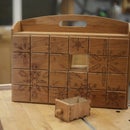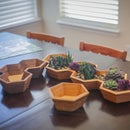Introduction: Wooden Gladius Swords
These were made as a fun project and an experiment. I wanted to see how the wooden blades would look when laminated with contrasting woods. I used jatoba (Brazilian cherry) and hickory woods. When finished, the contrast wasn't as stark as I hoped, but I think with better selection, you could achieve a better contrast.
Still, was very happy with the way they came out, a fun build for sure. For a full build along, enjoy the video as well which goes into depth on the whole process.
NOTE: These are NOT made for HEMA practice or real sparing, just for show or swinging around.
Step 1: Laminating the Blades
I started by re-sawing some flooring using a bandsaw. Because the blade width is less than 2", you could cut these down with most any table saw as well. I chose to make the core out of the jatoba, about 1/4' wide, and the exterior out of hickory, at about 1/16". It definitely helps to make the exterior as thin as possible.
My preferred method is to build everything around the width of the blade, creating a long tang that will eventually fit through the guard and into or through the handle. 1/4" width does work, but I've found 3/8" works best overall, regardless if you are making a laminated blade like this or a solid blade.
My bandsaw leaves a bit of a rough surface, so I sanded the laminations a bit, but not much, just spread some glue, grab some clamping cauls and clamp them together for a few hours. (I leave them overnight)
Step 2: Blade Templates and Profiles
I've included the templates I made for these, which include full size reference. I made two blades, one leaf shapes and one straight. For the leaf blade, cut out the guides, line up the pattern and tape them together. Trace your pattern on your blade and cut it out.
I made wooden templates to provide a router guide, but this isn't necessary, just cut to your line and clean up if needed.
Attachments
Step 3: Creating the Guard, Handle and Pommel Blocks
For this sword, it's designed to have the blade tang go all the way through to the pommel, which will connect everything together in the end. So each part is built with that in mind, and has a core that is 3/8" wide, or whatever the width of the blade is.
Using the actual blade as reference with the templates, the center of the guard is made of pieces that are 3/8 width and the right shape to fit the blade. It is glued together with wider block to form the rough overall size of the guard.
Similarly the handle is formed and glued, as is the pommel. These are all block shapes now, but what's most important is that they all fit together with the blade joining them.
Again, I took steps toward making multiple swords that isn't necessary for a single build. I built gluing boxes and guides, but if you are careful, you can do a simple glue-up with just the pieces.
Step 4: Shaping the Guard, Handle and Pommel
The handle:
Start by rough cuting via bandsaw or scrollsaw, and final shaped with sanding. An oscillating sander is ideal for this, but could also use a sanding spindle mounted in a drill press. Shape the handle to your liking, then smooth the edges for a comfortable grip.
The guard:
I used a round over bit for the base, and a taper bit for the top, but most importantly is to shape with care and caution. Create a stick that will securely fit into the open slot so you can manipulate the part from a safe distance.
The pommel:
This is turned round on the lathe, so it helps to knock off the corners. Clamps help hold the part secure while taking the corners off, and then some basic roughing and rounding on the lathe is all that's needed.
Step 5: Routing the Blade Edge
If you didn't laminate the blade, you can simply sand or round over the corners, but to reveal the inner laminate, I used a panel bit to cut a deeper profile.
Getting the right depth is tricky, and the bearing that comes with the panel bit is too small to work, and has to large a gap to the cutters, so I found a few washers held in place worked out well. I make sure to check that the washers are securely tightened each time I use this method, and cut in several passes to the final depth.
I found with the laminated edges, it's hard to get a perfect line of contrasting woods. Slight variations in your laminations or routing technique will vary the edge, so it's not a guarantee to work, but interesting to try all the same.
Step 6: Glue Up and Finishing
Glue up is simple, only advice is to apply glue only to the guard area first, get that in place, and then proceed down the handle, etc.
Finish with whatever you have on hand that will help bring out the character of your wood.
Step 7: Completed Swords
Hope this was helpful, and please share any images if you create some swords. I love the look of pure wooden swords, but of course you could paint and finish these to look like real props.
Stay safe, have fun, cheers!
-geekswoodshop














